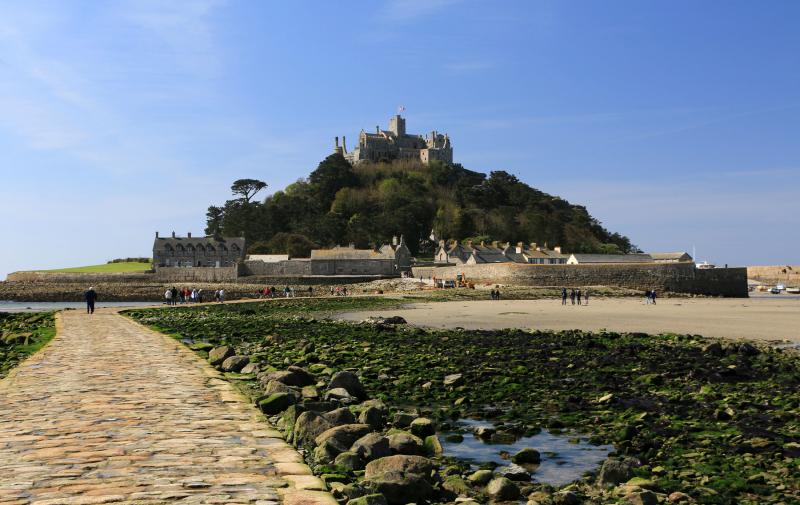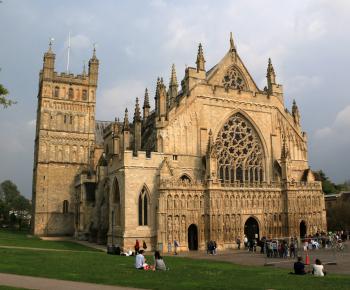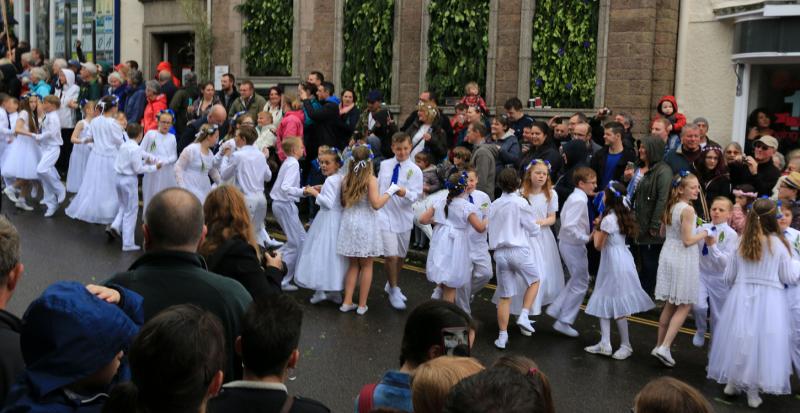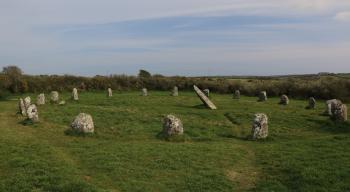Festivals, formal gardens and some fine coastal hikes enhance a self-drive tour of Devon and Cornwall
This article appears on page 18 of the February 2017 issue.
With three trips to the UK under our belts, Devon and Cornwall were still on the “bucket list” for my husband, R.C., and me. We decided to remedy that in the spring of 2016 (April 22-May 13).
We chose spring because it was a convenient time for us to travel, and it would have been the perfect time to visit southwestern England if it hadn’t been one of the coldest Aprils on record!
This was to be a self-planned, self-drive trip, the planning done primarily using Lonely Planet’s guide for Devon and Cornwall and TripAdvisor.com for lodging and restaurant recommendations.
Starting out
We took the train from London to Exeter, where we picked up (and later returned) our rental car, which we booked through Economy Car Rentals (206/317-1229; www.economy
carrentals.com). We paid $341 for the 3-week rental, with one driver listed. (R.C. is more experienced with left-hand driving on narrow roads, and distances were short.)
The only hassle was that they insisted we pick up the car at the Exeter airport, which required our taking the once-per-hour bus from the train station.
As we began planning, we discovered two early-May, ancient-origin festivals that are held annually in the area. This was too good to pass up, so we laid out the schedule for the entire trip to allow us to attend both festivals.
The Obby Oss Festival takes place in the north-coast fishing village of Padstow every year on May 1st (or May 2nd if the 1st happens to be a Sunday).
An “oss” is someone wearing a wide, circular cape with a mask resembling a horse. The ’oss dances through the village throughout the day, accompanied by another person known as the “teaser.”
Of the two festivals, this one is known as the drunken one. Drinking does start right around breakfast time.
Originally, there was only one ’oss, but in 1919 the temperance movement instigated a second ’oss to try to encourage more proper behavior during the festival. Followers of the original ’oss wear white outfits with red sashes; followers of the temperance ’oss have blue sashes.
Legend has it that the two horses must not meet until 5 p.m., when everyone comes together at the maypole in the main town square.
The same song is sung all day long by both groups, accompanied by drums and accordions.
The streets were crowded, since Padstow is a small village. We were able to get nice photos because the owners of our B&B allowed us to take some from our second-floor room, even though we had already officially checked out.
Flora folly
The second festival, called Flora Day, is held around May 8th in Helston, farther west and near the south coast. It has a much more refined atmosphere (or, as the locals told us, “We wait until later in the day to get drunk.”).
The main event of this festival is a formal dance or procession through the streets. You must have been born in the area to participate plus have the proper attire; tuxedos, top hats and floor-length gowns are required. Lily of the valley, worn by all dancers, had to be fake due to the cold weather they’d had.
Being chosen to lead the dance is the community’s top honor. We watched 156 couples participate.
There is also a children’s dance. Dressed in white, every child from the local school participates, passing through the streets by classroom with their teachers alongside wearing fancy, floral hats.
A larger selection of band instruments was involved in the music there, but the song and the dance steps were the same throughout both dances.
The amusing event of the day was called the “reenactment.” We asked several people what they were reenacting and got the same answer every time: “Oh, no one knows. It goes way too far back.”
There seemed to be characters from multiple points in history. A number of people were attired in leaves. There was a knight with a sword and a cross on his shield, plus a dragon and people dressed like Robin Hood and Friar Tuck. All of them were running around performing to an unwritten script.
We were incredibly lucky with our vantage point for this festival also. We stayed in Porthleven, a nearby seaside town that was much more picturesque than Helston. By sheer luck (and not knowing where we were going), we stumbled into a vacant spot in the town’s most central parking lot. After walking a couple of blocks, we were told we were in the best spot to see everything!
We found ourselves standing next to an 84-year-old man named Mark, originally from the area, who drives down from London every year for the festival. It turned out Mark’s son lived near our home in Colorado, so we were soon “adopted.”
Mark gave us tips on where to stand, bought us tea between performances and got us into conversations with some of the dancers.
Area activities
Besides these two festivals, there were a number of other things to delight us in this area.
St. Michael’s Mount, originally built by monks from its namesake location in France, is now a lived-in castle. At low tide, you can visit via a walkway from the shore, but at high tide, the only access is by boat. Supplies for the castle occupants are taken up via an interior tram.
In Exeter, the county seat of Devon, the remains of much of its original Roman city wall can still be seen around the town. Other notable sites include a Gothic cathedral that has the longest unbroken medieval vaulting in the world; Rougemont Castle gatehouse, which dates from shortly after 1066; a tribute to the “Devon witches,” who were the last to be executed for witchcraft in England, and a guildhall dating back to near 1330.
Walking and hiking opportunities also abound. You can walk the entire coastline, if you’re so inclined, or any portion of it. We chose to do shorter walks in search of archaeological sites, such as stone circles, stone rows or rocks with bizarre shapes.
These are abundant throughout the area, but some may be difficult to locate. Get a very detailed map and ask locally.
We found these stone constructions, believed to have been created between 4000 and 2500 BC, to be another example of Cornwall’s confused history. One of the best circles, called Merry Maidens, is locally interpreted as representing a group of maidens turned to stone because they were dancing on a Sunday, but that’s a modern Christian “sin.”
We hiked on the moors, including in Dartmoor National Park, where you can find stone circles and rows and ancient forests or walk in the “footsteps” of Sherlock Holmes, and Bodmin Moor, where we found rock formations called The Hurlers and the Cheesewring.
We also visited the ruins of Tintagel Castle, associated with the legend of King Arthur.
National Trust sites
Some of England’s finest properties and gardens have been preserved by the National Trust (www.nationaltrust.org.uk). In Devon and Cornwall, these include Buckland Abbey, once the home of Sir Francis Drake; Lydford Gorge, a hiking area with a waterfall, narrow chasms and bird-watching opportunities, and Lanhydrock, an estate with a 52-room house, formal gardens and a river walk where bluebells were in full bloom everywhere.
If you think you are going to visit enough National Trust sites to make it worthwhile, it may pay to join the organization (£63, or $80, per year for an individual membership).
We used bed-and-breakfasts for our lodgings throughout this trip, but our splurge ($590 for three nights) was the Cider House B&B (www.cider-house.co.uk), located on the grounds of the Buckland Abbey National Trust site. When we discovered this property on the Internet, we couldn’t resist.
Originally an on-site cider-storage house, the building has been renovated and is run by an enthusiastic young couple who want your stay there to be perfect. From offering coffee and tea anytime or desserts when we returned from dinner to suggesting walks or looking up the GPS location for a parking lot in Plymouth, they made us feel totally spoiled the whole time.
Breakfast offerings included homemade bread, honey from the property and perfectly poached eggs.
Dining out
Since southwestern England is a holiday destination for the Brits as well, there are a number of area restaurants owned and run by TV-cooking-show personalities plus many others of top quality. At the top of our favorites list was Peter Tavy Inn (www.petertavyinn.com), on the western edge of Dartmoor.
Peter Tavy is a 2-road town; take A386 north from Tavistock and follow the signs. You’ll need to arrive at the inn at opening time. Pick up your drinks at the bar, get your assigned table number, read the chalkboard menu and prepare to stay awhile before being served. But you won’t be disappointed! For the two of us, our meal cost $54, without alcohol or dessert.
Côte Brasserie (19-21 Cathedral Yard, Exeter; www.cote-restaurants.co.uk/cote/restaurant/details/exeter), another favorite, is actually part of a French food chain, but the food was excellent. They have early-evening specials that are a great deal ($56 and $45 for the two times we ate there, including drinks).
If you make reservations far enough in advance, ask for a table by the second-floor window facing the cathedral.
We’d also recommend St. Petroc’s Bistro (4 New St., Padstow; www.rickstein.com/eat-with-us/st-petrocs-bistro), where our meal cost $57.
Final thought
If you decide to attend the festivals mentioned, make reservations well in advance for both lodging and meals.
Each event was a very special treat.




